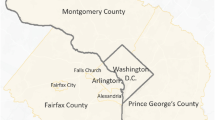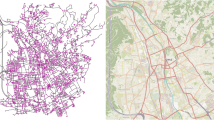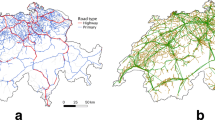Abstract
We present a novel network approach, supported by an agent-based simulation using empirical survey results, in order to generate origin-destination data and information about the road usage of a large, urban traffic system. Additionally, we investigate congestion and its effects on road usage due to traffic jam avoidance strategies. The investigated city serves as a case study and the presented method can be easily adapted for arbitrary traffic networks. We find that the use of network techniques offers various advantages and can replace aspects that are traditionally performed by computationally more expensive methods. Our method shifts the computational efforts from individual agent interactions to more elegant network techniques, which leads to much lower computation time and better scaling properties. Results are evaluated and show high conformance with measured data, especially if congestion effects are included. Furthermore, the obtained data can be used as an input for car-following models or other types of traffic simulation to gain even more information about the investigated traffic network.
Access this chapter
Tax calculation will be finalised at checkout
Purchases are for personal use only
Similar content being viewed by others
References
Wang, H., Fu, L.: Developing a high-resolution vehicular emission inventory by integrating an emission model and a traffic model: Part 1—Modeling fuel consumption and emissions based on speed and vehicle-specific power. J. Air Waste Manag. Assoc. 60(12), 1463–1470 (2010)
Caponio, G.: Commuting carbon dioxide (CO2) emissions: A study of ten Italian metropolitan cities. G. Caponio*, G. Mascolo, G. Mummolo, G. Mossa, S. Digiesi (2015)
Berkowicz, R., Winther, M., Ketzel, M.: Traffic pollution modelling and emission data. Environ. Model. Softw. 21(4), 454–460 (2006)
Steele, C.: A critical review of some traffic noise prediction models. Appl. Acoust. 62(3), 271–287 (2001)
Bando, M., Hasebe, K., Nakayama, A., Shibata, A., Sugiyama, Y.: Dynamical model of traffic congestion and numerical simulation. Phys. Rev. E 51(2), 1035 (1995)
Grote, M., Williams, I., Preston, J., Kemp, S.: Including congestion effects in urban road traffic CO 2 emissions modelling: Do Local Government Authorities have the right options?. Transp. Res. Part D: Transp. Environ. 43, 95–106 (2016)
Helbing, D., Armbruster, D., Mikhailov, A.S., Lefeber, E.: Information and material flows in complex networks. Phys. A: Stat. Mech. Appl. 363(1), xi–xvi (2006)
Barthélemy, M.: Spatial networks. Phys. Rep. 499(1), 1–101 (2011)
Nagel, K., Schreckenberg, M.: A cellular automaton model for freeway traffic. J. Phys. I 2(12), 2221–2229 (1992)
Bazzan, A.L., Klügl, F.: A review on agent-based technology for traffic and transportation. Knowl. Eng. Rev. 29(3), 375–403 (2014)
Chen, B., Cheng, H.H.: A review of the applications of agent technology in traffic and transportation systems. IEEE Trans. Intell. Trans. Syst. 11(2), 485–497 (2010)
Vissim, P.: 5.10 User Manual, PTV Planung Transport Verkehr AG, Stumpfstraße, vol. 1 (2008)
Balmer, M., Rieser, M., Meister, K., Charypar, D., Lefebvre, N., Nagel, K.: MATSim-T: Architecture and simulation times. In: Proceeding of the Multi-agent Systems for Traffic and Transportation Engineering, IGI Global, pp. 57–78 (2009)
Krajzewicz, D., Hertkorn, G., Rössel, C., Wagner, P.: SUMO (Simulation of Urban MObility)-an open-source traffic simulation. In: Proceedings of the 4th Middle East Symposium on Simulation and Modelling (MESM20002), pp. 183–187 (2002)
Nagurney, A., Dong, J.: A multiclass, multicriteria traffic network equilibrium model with elastic demand. Transp. Res. Part B Methodol. 36(5), 445–469 (2002)
Cascetta, E.: Estimation of trip matrices from traffic counts and survey data: a generalized least squares estimator. Transp. Res. Part B Methodol. 18(4), 289–299 (1984)
Caceres, N., Wideberg, J., Benitez, F.: Deriving origin–destination data from a mobile phone network. IET Intell. Transp. Syst. 1(1), 15–26 (2007)
Tomschy, R. et al.: Oesterreich unterwegs 2013/2014: Ergebnisbericht zur oesterreichweiten Mobilitaetserhebung. Oesterreich unterwegs 2013/2014 (2016)
Boeing, G.: OSMnx: New methods for acquiring, constructing, analyzing, and visualizing complex street networks. Comput. Environ. Urban Syst. 65, 126–139 (2017)
Map, O.S.: Open street map 18, Retrieved June (2017)
Statistik Austria: Registerzählung 2011. Statistik Austria Pendlerstatistik (2011)
FGSV: Richtlinien für die Anlage von Straßen (RAS) Teil: Querschnitte (RAS-Q). FGSV-Verlag, Köln (2006)
Höfler, F.: Verkehrswesen-Praxis-Band 1: Verkehrsplanung (2004)
De Palma, A., Rochat, D.: Understanding individual travel decisions: results from a commuters survey in Geneva. Transportation 26(3), 263–281 (1999)
Author information
Authors and Affiliations
Corresponding author
Editor information
Editors and Affiliations
Rights and permissions
Copyright information
© 2018 Springer International Publishing AG
About this paper
Cite this paper
Hofer, C., Jäger, G., Füllsack, M. (2018). Generating Realistic Road Usage Information and Origin-Destination Data for Traffic Simulations: Augmenting Agent-Based Models with Network Techniques. In: Cherifi, C., Cherifi, H., Karsai, M., Musolesi, M. (eds) Complex Networks & Their Applications VI. COMPLEX NETWORKS 2017. Studies in Computational Intelligence, vol 689. Springer, Cham. https://doi.org/10.1007/978-3-319-72150-7_99
Download citation
DOI: https://doi.org/10.1007/978-3-319-72150-7_99
Published:
Publisher Name: Springer, Cham
Print ISBN: 978-3-319-72149-1
Online ISBN: 978-3-319-72150-7
eBook Packages: EngineeringEngineering (R0)




